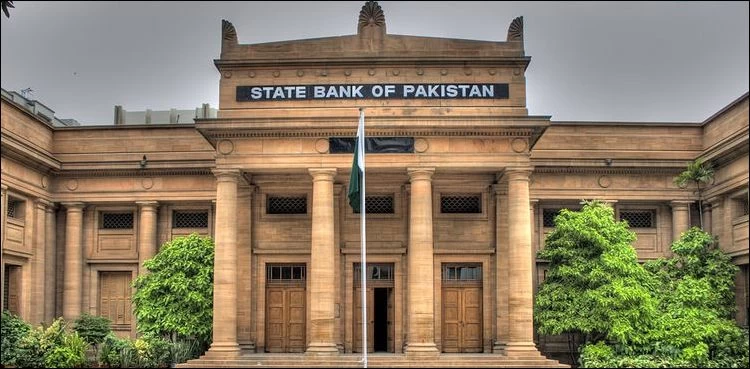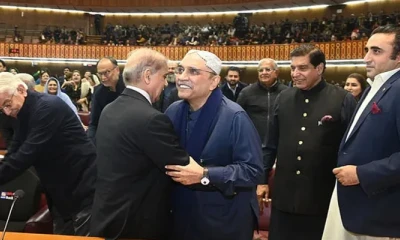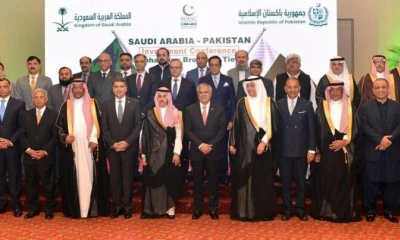Business
State Bank announces monetary policy, maintains interest rate
State Bank of Pakistan (SBP) has announced the monetary policy for the next two months maintaining the interest rate at 7 per cent.

According to SBP, a meeting of the Monetary Policy Committee (MPC) of the State Bank of Pakistan was held in which the economic situation of the country was considered.
According to the State Bank of Pakistan, large-scale industrial production has increased due to which most of the economic activity figures are improving while the inflation rate will remain between 7% and 9% during the current financial year.
According to the press release issued by SBP, Monetary Policy Committee (MPC) decided to maintain the policy rate at 7 per cent. The MPC further noted that since the last meeting in January, growth and employment have continued to recover and business sentiment has further improved. While still modest, at around 3 per cent, growth in FY21 is now projected to be higher than previously anticipated due to improved prospects for manufacturing and reflecting in part the monetary and fiscal stimulus provided during Covid.
According to SBP estimates, the recent increase in electricity tariffs and sugar and wheat prices accounts for about 1½ percentage points of the 3 percentage point increase in inflation between the January and February out-turns.
The recent increase in electricity prices will continue to manifest in headline numbers in the coming months, keeping average inflation in FY21 close to the upper end of the previously announced range of 7-9 per cent, the statement added.
The committee also highlighted that the output gap is still estimated to be negative, core inflation continues to be relatively subdued, and inflation expectations—while drifting up somewhat due to the recent increase in headline inflation numbers—are still well-anchored.
Looking ahead, as the temporary increase in inflation from administered prices wanes, inflation should fall to the 5-7 per cent target range over the medium-term, states SBP.
Given the underlying inflation trajectory, the MPC felt that the existing accommodative stance of monetary policy remained appropriate to support the recovery while keeping inflation expectations well-anchored and maintaining financial stability.
From a policy mix perspective as well, given that fiscal policy is expected to remain contractionary to reduce public debt, the MPC noted that it was important for monetary policy to be supportive as long as second-round effects of recent increases in administered prices and other one-off supply shocks do not materialize and inflation expectations remain well-anchored.
On the growth front, the MPC noted that despite recent momentum, risks remain due to the emergence of a third, more virulent wave of Covid in Pakistan just as the vaccine roll-out is beginning. In terms of the inflation outlook, this summer’s wage negotiations and any new tax measures in the next year’s budget could add further supply-side shocks.
According to MPC, besides optimism about a stronger US-led world recovery this year is translating into higher international commodity prices, including both food and oil, which could continue to feed into domestic inflation. These trends in the outlook for inflation and growth will need to be carefully monitored.
In the absence of unforeseen developments, the MPC expects monetary policy settings to remain broadly unchanged in the near term.
In reaching its decision, the MPC considered key trends and prospects in the real, external and fiscal sectors, and the resulting outlook for monetary conditions and inflation.
SBP noted that Large-scale manufacturing (LSM) grew further by 10.8 per cent (y/y) in December 2020 and 9.1 per cent (y/y) in January 2021. Through the first seven months of FY21, LSM has grown by 7.9 per cent, compared to a contraction of 3.2 per cent during the same period last year. A wide range of other high-frequency indicators signal robust growth, including sales of fast-moving consumer goods, automobiles, cement, POL and electricity. In services, transportation is benefiting from the pick-up in manufacturing, while business sentiment indicators foresee further improvements in both activity and employment in the coming months. In agriculture, all major Kharif crops except cotton have surpassed production levels in FY20 and targets for FY21, and indicators of input conditions—such as tractor sales, fertilizer usage, water availability, and weather—suggest strong prospects, especially for wheat.
The current account remains in surplus of $0.9 billion through the first seven months of FY21 on the back of record remittances, relatively subdued domestic demand and a nascent recovery in exports. At $230 million, the current account deficit in January was around one-third of its level in December 2020. As the economy recovers, the trade deficit is widening somewhat on the back of imports of capital goods and industrial materials as well as food, together with rising international commodity prices. Nevertheless, the current account deficit in FY21 is still expected to remain below 1 per cent of GDP given the out-turn to date, continued strong prospects for remittances—which have remained above $2 billion for the last 9 months— and the on-going pickup in exports, especially high value-added textiles. The recent staff-level agreement on the resumption of the IMF program has further boosted prospects and ensured that external financing needs will be comfortably met, the committee noted.
The press release stated that Favourable developments and improving sentiment contributed to an additional 3.4 per cent appreciation in the PKR since the last MPC meeting, which now stands close to a one-year high, and helped to keep SBP’s foreign exchange reserves around $13 billion, levels last seen three years ago.
Fiscal developments continue to evolve largely in line with the consolidation envisaged in this year’s budget, as the necessary fiscal stimulus imparted in Q4 of FY20 is unwound. During H1 FY21, the fiscal deficit stood at 2.5 per cent of GDP, broadly unchanged from the same period last year despite higher interest and Covid-related payments. This mainly reflects healthy growth in revenues, with FBR net tax revenue provisionally growing by 6.0 per cent (y/y) through February to surpass target levels despite higher refunds, and non-tax revenue increasing by 16.8 per cent (y/y) through December on account of SBP profit transfers and the petroleum levy. Despite higher non-interest current expenditures, the primary balance posted a surplus of 0.7 per cent of GDP during H1 FY21, says SBP.
-

 Business 1 day ago
Business 1 day agoGold price jacks up by Rs2400 per tola in Pakistan
-

 Pakistan 2 days ago
Pakistan 2 days agoFaizabad Dharna Inquiry Commission gives clean chit to Faiz Hameed
-

 Pakistan 1 day ago
Pakistan 1 day agoPM Shehbaz Sharif meets Saudi Foreign Minister
-

 Pakistan 19 hours ago
Pakistan 19 hours agoPresident Zardari to address in joint session of Parliament
-

 Pakistan 22 hours ago
Pakistan 22 hours agoNawaz Sharif gets clean chit in Tosha Khana vehicles reference
-

 Business 2 days ago
Business 2 days agoSaudi delegation to meet apex committee of SIFC today
-

 Pakistan 2 days ago
Pakistan 2 days agoFinance Minister, SG CVF discuss ways to address climate challenges
-

 Pakistan 1 day ago
Pakistan 1 day agoDeliberations underway to change Governor Sindh































